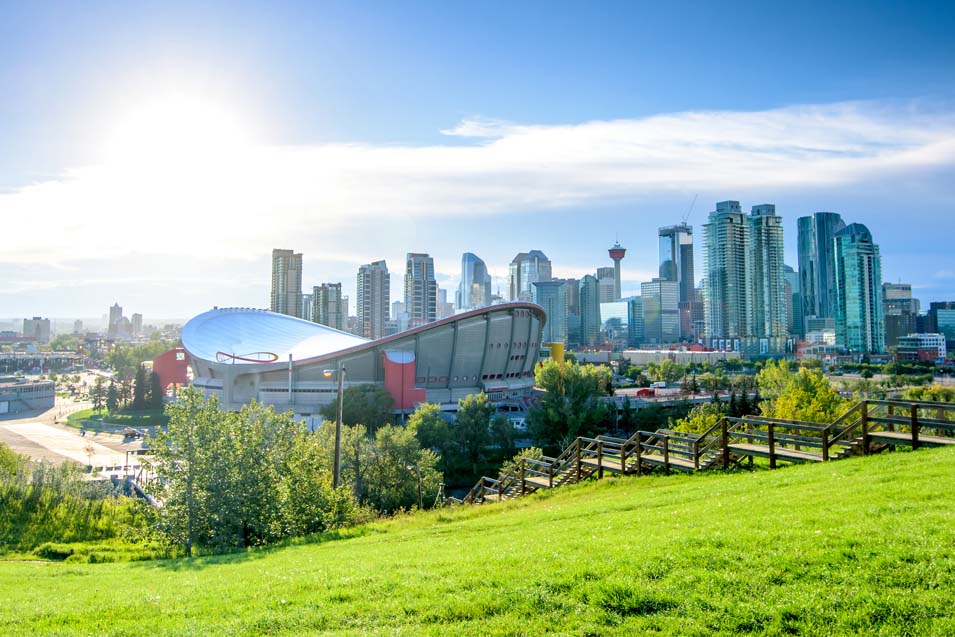Chinook winds are a phenomenon that largely affects the province of Alberta, Canada, as well as areas found in the Pacific Northwest of the United States. Since Chinooks bring with them the potential for great destruction to your home, it’s important to understand what they are and how you can be prepared for them. What is a Chinook and how does it cause broken pipes and flooding?
What is a Chinook?
Chinook winds typically originate off the Pacific Ocean. They rapidly increase in intensity, moving from temperatures as low as -20 degrees Celsius to 10-20 degrees Celsius in a very abbreviated time span; often as little as a few hours or several days. These vigorous winds rise to warm temperatures quickly before plummeting back to their starting point again. They blow in a western trajectory, primarily targeting the province of Alberta with Lethbridge and Calgary two of the cities that experience the most damage from these winds.
Chinook winds achieve their strength when they reach their maximum warmth and collide with the Rocky Mountains, causing a rapid cooling. When the cooling process begins, it results in precipitation in the form of rain or snow. The air loses its moisture and begins to move downwards towards flatter, more easterly ground. As the wind starts to move toward the west or the southwest, it begins to pick up speed and again increases in temperature, often reaching hurricane force. A previous storm in Lethbridge caused by Chinook winds experienced gale forces of up to 106 miles per hour.
When Chinook winds gather strength and affect a region, they can cause a number of problems for homes. Eavestroughs can become dislodged from houses and soffits can begin to loosen and sag. Chinook winds are sometimes referred to as “snow eaters” because they easily cause up to 12 inches of snow to evaporate in a matter of hours, leaving behind structural damage to homes.
Is There a Specific Chinook Season?
Chinooks are most commonly seen in the winter months. This is due to the large snow cover that is predominant in these regions during the coldest times of the year. Snow typically blankets the Rocky Mountain range in the winter, leading to a rapid cooling of the warm air blowing in from the Pacific Ocean.
The city of Lethbridge is the city that is affected the most, often experiencing as many as 30 to 35 Chinooks per year. However, Calgary is also regularly a victim of the damage caused by Chinooks.
Experts agree that the incidents of Chinook winds seems to be on the incline. This is attributed largely to global warming.
What are Some of the Most Commonly Seen Effects of Chinooks?
Chinooks leave a lot of damage in their wake. Though most of it is seen in buildings and homes, Chinooks also have a powerful impact on everything from the soil and local agriculture to the health and well being of people living within Chinook regions.
Here are some of the most common problems associated with Chinooks:
- Dramatic drops in humidity
- Rapid ice loss in rivers and lakes
- Sound carrying great distances
- Soil quality deterioration, and in may cases, loss
- Tree death
- Early photosynthesis of vegetation leading to dehydration and loss of plant life
- Soil moisture depletion
- Wire fence electrification leading to accidental death of animals
- Wood splitting
- Headaches
- Exacerbated nervous disorders
- Stroke
- Increase in fire hazards
- Greater risk of forest fires
- Home and property damage
How Do Chinook Winds Affect My Home?
Rapid shifting of temperatures as a result of Chinook winds leaves many homes in jeopardy. When temperatures reach a point of extreme cold, pipes will begin to freeze. Though Chinook winds carry with them warmth, they typically melt only the surface snow and ice, leaving behind them a vast depth of frost underground. Since this layer of frost reaches approximately 10 feet, it penetrates to the area where most water mains are located, leaving pipes in peril of bursting from extreme cold.
During the winter months, a layer of snow on the ground acts as a form of insulation, providing protection for water mains and household pipes. When Chinook winds cause the snow to vaporize, there is nothing in place to protect pipes from freezing. Experts recommend keeping a slow but steady flow of water moving through their taps to keep their pipes from becoming clogged with ice.
Unfortunately, burst pipes that occur on your property are your financial responsibility. However, the province of Alberta has instituted a program that benefits homeowners that take advantage of their frozen pipes initiative by maintaining a continuous flow of water through their taps. This program provides financial relief from excessively high water bills as a result of the additional water usage.
In addition to frozen and possibly burst pipes, Chinook winds can also be responsible for flooding. When the warm Chinook air combines with snow, it causes a rapid melting. This excess water needs a place to go, and sometimes, the runoff finds its way inside a home’s foundation, causing flooding of basements and other living spaces.
Homes which have a lot of additional snow piled on their rooftops may also experience leaking when Chinook winds cause an accelerated thaw. This rapid running of water off the sides of roofs can cause external features such as eavestroughs and soffits to become loose.
How Can I Prevent My House’s Pipes from Freezing?
The process of water moving from a liquid to a solid involves an expansion of approximately 9 percent. When pipes freeze, this expansion occurs quickly and with great force involved, causing the metal to fracture. Though some pipes burst as soon as the water turns to ice, this process often takes place when the pressure exerted against the pipe meets a weak point, causing a rupture.
Thankfully, there are some measures you can put in place to keep your pipes from freezing during the cold winter months, and particularly, when Chinook winds affect your area. These include:
- Be on the lookout for slow running faucets
At the first sign of a water flow that is slower than usual, it may be that your pipes are beginning the process of freezing. It is still possible to reverse this process if caught early enough.
- Increase the heat in your home
Warming the temperature inside your house can help keep water in your pipes from succumbing to freezing.
- Make use of fans to distribute heat through unused rooms
Rooms in your home that are regularly closed off or not in use may become too cold. You can put fans in these areas to help heat to move through the rooms to increase their temperature.
- Keep doors to vanities and cabinets open to allow warm air to reach pipes
Doors are an obstacle to maximum heat flow. To help your pipes maintain a good temperature, keep vanity and cabinet doors open to allow heat to permeate the region.
- Disconnect garden hoses
Outdoor faucets can and will burst if allowed to remain connected to a garden hose during the cold months.
- Close your garage door
A lot of excess heat can be released from an open garage door. Keep it closed to provide an extra measure of heat insulation.
- Allow water to run at a slow but steady pace on a continuous basis
Keeping water moving is a critical element of preventing frozen pipes.
- Heat the affected pipe
If it is evident that the freezing process has begun, it is a good idea to safely heat the pipe to allow the water to reliquify itself.
- Consider an electric heat cable
Electric heat cable gives an extra layer of protection to keep pipes safe during bitterly cold weather. These are controlled by a thermostat that distributes heat only when needed. The one down side to installing an electric heat cable is its high cost.
Live in an area regularly affected by Chinook winds? Consider some of our top tips to keep your house in tip top shape all year round.





Leave a Reply
Want to join the discussion?Feel free to contribute!